We kicked
off our trip at Quebec’s Winter Carnival, the world’s
largest winter celebration. Unlike those other Mardi Gras extravaganzas
in Rio and New Orleans, this Carnival is a wholesome, affordable,
and family-friendly celebration. A giant snowman named Bonhomme is
the king of the carnival, and his likeness appears everywhere: in
restaurants, stores and on street corners. Around his midrift is a
one of the most prominent Carnival symbols, a ceinture fléchée.
This woven red-striped sash is a traditional piece of folk art in
Québec and varies in design. The sash is also a popular souvenir.
French Canadians love to play in the snow and
the festival shows North America’s only walled city in all its
snow-blanketed historic and cultural glory. Although 98 per cent of
the province’s residents are French-speaking, English is widely
spoken and the Québécois are the epitome of graciousness
and hospitalité.
On our first night in town, we visited the
Érablière le Chemin du Roy, a traditional maple
sugar shack tucked away in a snowy wood. (Maple syrup products are
a principal industry in Québec). Although we had just arrived,
we were immediately thrust into the party atmosphere, stomping our
feet to a traditional gigue played on the harmonica and wooden
spoons by a musician dressed in traditional bûcheron
(lumberjack) style. The musical roots are Celtic and a to my ear a
distant cousin to bluegrass.
The traditional foods we sampled evoked a 400-year-old
“peasant” style: pork rings, hearty thick pea soup, maple
syrup-smoked ham, and the famous Québécois dish la
tourtière, an ample pastry-covered meat pie that is the
embodiment of comfort food. We made toothsome maple syrup taffy (think
maple syrup popsicles) by pouring maple syrup into wooden troughs
packed with fresh snow and twisting it onto wooden sticks. We capped
that magical evening with a sleigh ride through the sugar maple stand
under a luminous moon.
Diverse and unusual (to the visitor) carnival
events are scattered over numerous sites throughout the city and each
is pays homage to winter. Bundled in multiple layers, we visited Bonhomme’s
Palace during the day to view ice sculptures created by artisans from
around the world. At night in his palace, there was a dance party
with parka-clad participants. On a clear frosty night we watched as
young couples danced to Big Band tunes out of the 30s and 40s. We
also ate “beavertails,” a fried dough confection topped
with cinnamon or chocolate — or both!
During the day we took in an old-fashioned
soapbox derby on city streets lined with throngs of well-wishers.
We tried snow tubing in big yellow inflatable rings, careening down
the steep hills surrounding Québec's Citadel right by the famous
Plains of Abraham where in 1759 England wrested the Canadian colony
from France. We sampled caribou, a powerful mixture of brandy,
vodka, sherry and port. This traditional liquid fare is guaranteed
to warm the body, and is carried by some festival-goers in a plastic
red cane, for stealthy sipping.
We tried ice fishing with a bunch of rosy-cheeked
kids; shades of Grumpy Old Men danced through my head as I waited
for the trout to take the bait. As the snow swirled in a nighttime
cityscape enhanced by colorful Carnival lights, we listened to adults
and kids alike sound their enthusiasm on traditional red plastic trumpets
during a night-time parade that wound its way through Québec's
narrow streets.
And then there was a one-of-a-kind canoe race
(longboats really) across the St. Lawrence River in which teams of
competitors leapt from canoe to ice floes and back again, braving
the daunting currents of the river, not to mention the freezing temperatures.
Previously we had witnessed qualifying runs on the snowy expanse of
the Plains of Abraham, with uber-fit men and women’s teams clad
in multi-colored stretchy sports fabric. Winter in Québec is
a challenge in itself but during the Carnival's impressive events,
such extreme athletic endeavors push the envelope in an even more
rigorous and light-hearted style. Winter is the co-competitor and
is to be admired, respected, and challenged.
At dinner one night at La Crémaillère,
one of the city’s best tables, we got an ample “taste”
not only the the chef’s gastromic accomplishments but of Québec
City's world-class reputation for the culinary arts. In an elegantly
furnished heritage building in the heart of the old city, we feasted
on dishes that blended classic French cuisine with contemporary Italian
touches such as: paparadelle with escargot and spinach, salmon stuffed
with sauerkraut, and a to die for three-chocolate mousse.
The province of Quebec is three times the size
of Spain and five times the size of Japan. In fact, only 18 countries
are larger than Quebec. The land is dotted with lakes and rivers,
and bisected by the 746-mile-long St. Lawrence River, the principal
“highway” in the original French colony and before that
for the First Nations in this part of the Americas. One-fourth of
Canada’s population lives in Québec.
Post-Carnival, we got to sample the unique
country inns that take full advantage of this beautiful geographic
region. Hôtellerie Champêtre (Québec Resorts and
Country Inns) is a collection of 22 well-priced, family-run, independent
hotels spread across 12 regions in the Québec countryside.
In addition to offering charming accommodations, they are acclaimed
for their gastronomy. The chefs work closely with a host of local
producers and purveyors of meat and poultry, dairy, vegetables, and
fruits.
It was a blindingly and pure-white day with
a serene silence that almost defies description when we arrived at
Auberge Lac St. Pierre. More manor house than inn, it boasts a spectacular
proximity to nature, perched above the silver-blue Lac St. Pierre
and the St. Lawrence River. In other seasons, herons, geese and ducks
are plentiful here. The starkly beautiful landscape in which the Auberge
is located has been declared a UNESCO biosphere world reserve.
After braving the brisk temperatures to vigorously
snowshoe through the silent woods, we sat à table
for our reward: a three-course lunch of rich, earthy mushroom chowder,
chicken with maple syrup and cardamom, and chocolate and passion fruit
soufflé. Susan fretted briefly about the calories, but I was
not-so-secretly thrilled. What a way to embrace Québec's regal
season!
At Le Baluchon, a self-contained village where we spent the night,
we met several visiting Mexicans who delighted in the crystalline
snow. For many of them, it was their first sighting of the pristine,
powdery white stuff. The furnishings of our inn were comfy-cozy as
were the thick white robes we were provided with. But it was the setting
that was truly memorable. The individual lodges we were ensconced
in were nestled in a wooded valley and connected to the central areas
by wooden walkways.
Before dinner, we sampled two local apéritifs:
the first a sortilège, a Canadian whisky flavored
with a maple syrup liqueur, and then a fortified red wine. The evening’s
table d’hôte menu included salad with shredded candied
duck, rabbit medallions, local cheeses and maple syrup cake; at about
$35, a multi-course meal at a fixed price and a real value for U.S.
travelers. The menu however was a challenge; how to choose between
trout and caribou médaillons?
On the property, there was a cabane à sucre (maple
sugar shack) and an equestrian center. But it was the spa in this
self-contained village that gave me that died-and-gone-to-heaven feeling.
An aromatherapy massage might not have worked off any of our culinary
indulgences, but it did soothe our muscles unaccustomed as they were
to these winter realities.
At the contemporary Auberge Lac-à-l’Eau-Claire,
huge picture windows provided unbroken views to the ice-covered lake.
Susan donned a bulky thermal suit and went snowmobiling while I visited
the tiny ice huts where two Montreal fishermen were warming themselves
with comfortable chat; quite protected and separate from the wintry
scene outside. They had already caught several rainbow trout. Their
wives (quite sensibly?) were back in their rooms indulging in a good
winter day's read. Later, Susan and I met back in the expansive living
room where rosy-cheeked, breathless kids and adults trundled in, throwing
off their coats, scarves, hats and gloves to relax by the fire with
hot tea, before indulging in another leisurely, delicious gourmet
lunch.
Susan must have been of a Nordic ethnic group
in a previous life; she was hankering to get to the Hôtel
de Glace. Located less than an hour from Québec, this
particular ice hotel (in its sixth year) is modeled after the one
in Sweden. Rising out of a expanse of white, the buildings appear
as blue-white, gently rounded pyramids with one set of simple wooden
doors. |
|
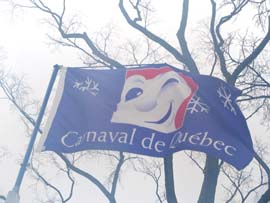
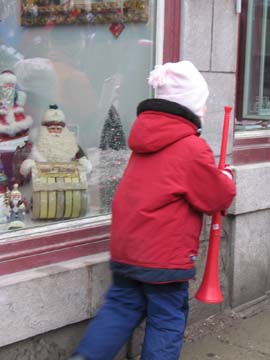
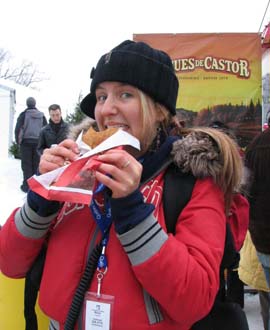
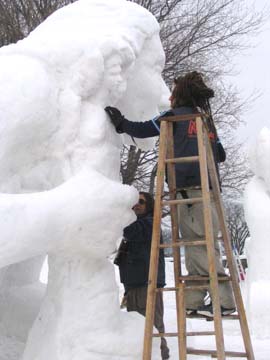
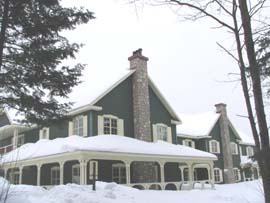
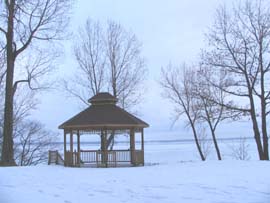
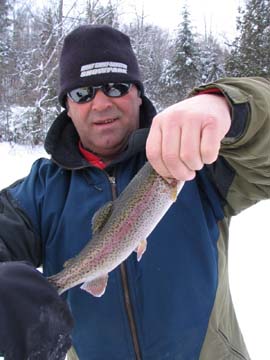
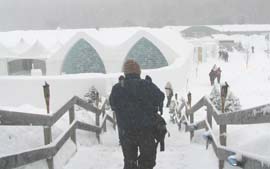
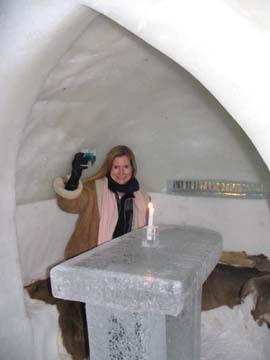
|
|
It takes
$2.5 million Canadian to build it each year and nearly a month of
work to construct the facility that stays in place for just 86 days.
A no-melt mixture of four parts water and one part snow is blown between
wooden molds which are then removed after they freeze solid. The process
can take up to three days and creates four-foot thick walls and two-foot
thick ceilings.
The grand hallway features fiber-optic lighting
that constantly changes colors; 34 theme rooms (including the Egyptian
and Great Wall of China suites); two bars (one sponsored by Absolut
vodka which you drink out of small blocks of ice); a chapel (they
will host more than 30 weddings this winter); and galleries (exhibits
include ice carvings and photography under ice). Visitors who are
not staying the night plunk down $14 to visit the property during
the day.
If you are a collector of novelty experiences,
a stay at the Ice Hotel will dazzle your friends and colleagues. Upon
check-in, you are given a key to a plywood locker in which to store
your suitcase and a towel and robe. There’s a communal locker
area and shower facilities in an area removed from the actual ice
structures. You are also given a coupon for a three-course meal at
the adjoining Duchesnay resort, along with a back-up room there in
case you can’t make it through the night, though we were told
only five per cent actually use it. I noticed the guest book contains
an entry from an Atlantan; my home state.
A staffer explained how to prepare for bedtime.
You undress in your sleeping bag (rated to -40 Celsius) and keep your
clothing inside with you — otherwise the garments would freeze.
After dinner, we showered and then sat and read by the fireplace (more
for looks than heat). At 9:45 p.m we sprinted to our suite. Although
there was a sauna and hot tub in the ice hotel, we decided to forgo
them.
It was a bit awkward getting into the sleeping
bag, but finally I managed to do it. It was -8 Celsius in the room;
-15 outside. (Zero is the freezing point in Celsius.) In other words,
frigid. The sleeping bag was partially insulated by a fur rug underneath
it on a wooden plank, all of which was on the bed — a huge block
of ice. I kept my hat pulled down over my head, but my breath was
still visible. I slept fitfully, as did Susan who usually sleeps like
the dead. I kept thinking, “How long have I been sleeping? Am
I cold? Could I feel it if I were numb? Do I need to pee? Where is
the chamber pot?” The answer to the last self-query is there
isn’t one. You have to get dressed and go outside to pee.
Having braved the brisk night, the next morning we went dog-sledding.
Snuggled into the wooden sled, sticky snow falling overhead, Susan
and I yelped as loudly as the dogs. We had caught the spirit.
If You Go
La
Crémaillère
Érablière
le Chemin du Roy
Hôtellerie
Champêtre (Quebec Resorts and Country Inns)
The
Ice Hotel
|
|